|
(click
on the main point headings to jump to the selected
location in the notes)
About
"Fungal" Thalli- a review:
Fungi
characterized by a distinctive, multinucleate,
vegetative
(somatic) thallus (body) called
the mycelium
(singular)
mycelia
(plural)
The
mycelium consists of a branching system of walled
tubes called
hyphae
(plural)
hypha (singular)
Mechanisms
of hyphal growth* are
apical extension
& lateral branching.
* non reproductive
growth
Not only unit of
structure, as many fungi and fungal-like protists
are nonhyphal organisms
Better to refer to
vegetative body of a fungus as a thallus
(Back
to main points)
Thallus
types
Holocarpic
vs Eucarpic
A.
Holocarpic (Holocarpism)
Whole
thallus of fungus becomes converted into a
reproductive cell*
Found among:
1. Chytridiomycota
2.
Hyphochytridiomycota
3.
Plasmodiophoromycota
4. Oomycota
5. Ascomycota
6. Basidiomycota**
7. Fungi imperfecti
* "simplest
thalli"
** if stretch
definition
64
(Back
to main points)
a. S.
cereviseae - Hemiascomycotina
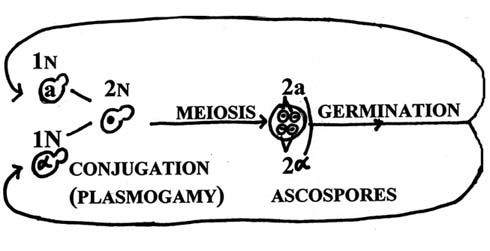
b. Synchytrium
- Chytridiomycota
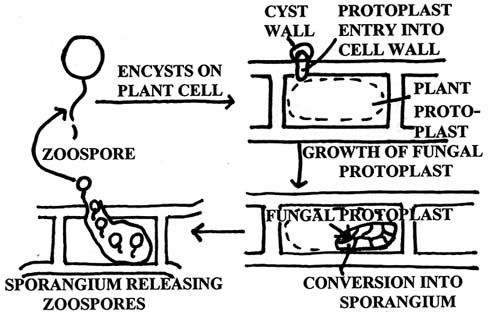
65
(Back
to main points)
Eucarpic
(Eucarpism) Thallus
-
differentiates into distinct vegetative and
reproductive portions
- found
among all divisions
trends
to complexity (hyphal construction)
1.
Monocentric (monocentrism)
Thallus consists of
single reproductive cell attached to
substrate hyphae
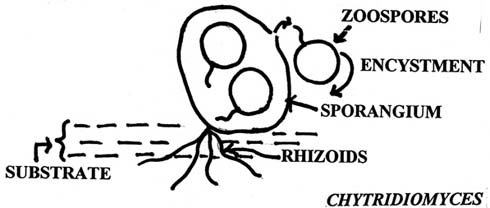
Chytridiomycota
Oomycota
Hyphochytridiomycota
(Back
to main points)
2.
Polycentric (polycentrism)*
Thallus
has many reproductive centers**
Simplest
or at least step above Chytridiomyces might
be Nowakowskiella***
Extensive
rhizoidal system with many sporangia
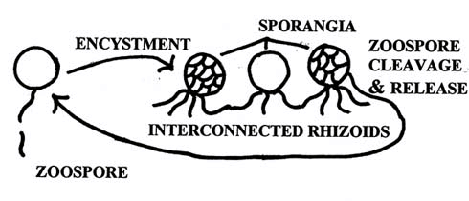
* most
"fungi" eucarpic & polycentric
* all
groups except plasmodiophoro-mycota
***
Chytridiomycota
67/69
(Back
to main points)
Blastocladiella*
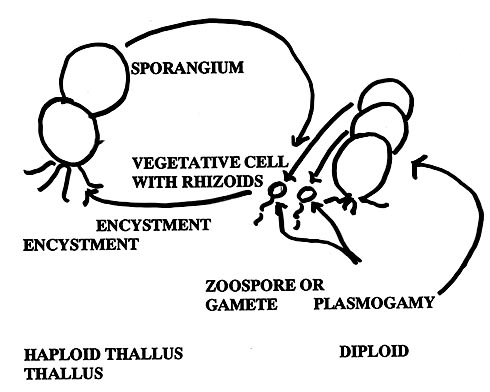
*Chytridiomycota
70
(Back
to main points)
Hyphal
"fungi" (obvious hyphae) found among:
|
Septation
Trends
|
|
Tend
to be coenocytic*
|
1.
Chytridiomycota
|
|
2.
Oomycota
|
|
Tend
to be coenocytic or irregularly septate
|
3.
Zygomycota
|
|
Tend
to be regularly septate
|
4.
Ascomycota
Hemiascomycotina
Euascomycotina
|
|
5.
Basidiomycota
Heterobasidiomycotina
Homobasidiomycotina
|
|
6.
Fungi Imperfecti
Hyphomycetes
Coelomycetes
Mycelia
Sterilia
|
*
coenocytic/coenocynism = growth and nuclear
division w/o cytokinesis
73
(Back
to main points)
Septal
conditions in "fungi"*
|
Fungal-like
protists and Chytridiomycota
|
tend
to be aseptate except to delimit
reproductive cells (e.g. sporangia,
gametagia)
septa
when formed "complete" (no pores)
|
|
Zygomycota
|
tend
to be aseptate or have septa formed at
irregular intervals in their hyphae (septa
when formed "complete")
|
|
Ascomycota
& basidiomycota yeasts
|
tend
to form complete septa or micropore septa
between mother and daughter cells
|
*
Fungi includes fungal-like protists and
Chytridiomycota
74
(Back
to main points)
Septa
of hyphal Ascomycota and Basidiomycota
|
Ascomycota
|
tend
to form hyphal septa at regular intervals
septa
are "simple septa" with a central
septal pore & Woronin bodies
|
|
Basidiomycota
|
tend
to form hyphal septa at regular intervals
septa
are "dolipore" or "pulley
wheel" type with central pore,
parthenosome membranes or pulley wheel plug.
|
77
(Back
to main points)
Review
- "fungal" thalli/thallus
Appear
to be trends in fungal vegetative and reproductive
structure (thallus) from simple --> complex
-->(?) simple.
These may be evolutionary trends.
Holocarpic
- whole vegetative thallus converted to
reproductive center
Eucarpic
- separation of vegetative &reproductive
function
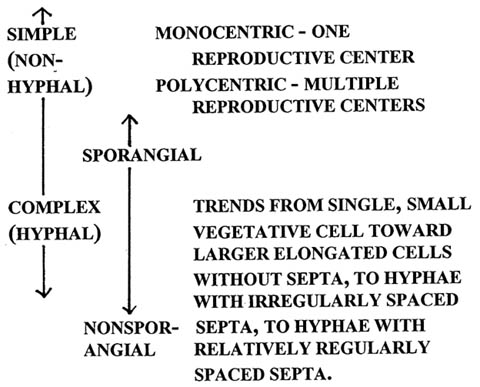
79
(Back
to main points)
"Fungal"
nuclear conditions
1.
Most nonyeast "fungi" multinucleate,
whereas most "yeasts" uninucleate
2.
Among fungi there are haploids and diploids
a.
Majority of "fungi" vegetative haploids
b.
Oomycota vegetatively diploid
c.
Some "fungi" alternate haploid and
diploid phases
d.
Some members of predominantly haploid groups are
vegetatively diploid
Haploidy
= 1 set of chromosomes per nucleus
Diploidy
= 2 sets of chromosomes per nucleus
3.
Terms associated with genetics of multinucleate
"fungi"
a.
Homokaryotic/homokaryons
b.
Heterokayotic/heterokaryons
c.
Monokaryotic/monokaryons
d.
Dikaryotic/dikaryons
5-17/6-3
(Back
to main points)
Nuclear
conditions related to multinucleate states of
fungi
1.
Homokaryons - multinucleate forms with all nuclei
genetically identical [or at least identical with
regard to gene(s) in question]
2.
Heterokaryons - multinucleate forms with
genetically different nuclei coexisting in the
same cytoplasm
3.
Dikaryons - specialized heterokaryons in which
nuclei having different mating-type gene(s)
co-existing in the same cytoplasm
4.
Monokaryons - homokaryons or heterokaryons having
only one mating-type gene(s) set.
5.
Exact perpetuation of the dikaryotic condition
occurs in some higher fungi.
a.
In many Euascomycotina by crozier
formation*
b.
In some Heterobasidiomycotina and some
Homobasidiomycotina by clamp formation **
*immediately
prior to ascus production.
**during
normal hyphal growth of dikaryons.
79/81b
(Back
to main points)
Differences
between:
homokaryons
and heterokaryons
vs
homozygotes
and heterozygotes
Former
usually refer to haploid condition, whereas latter
to the diploid condition*
Phenotypic
results could be the same.
Dikaryotic
condition very unique because usually opposite
mating type nuclei fuse.
*However
could refer to diploids too.
80
(Back
to main points)
Uninucleates
vs multinucleates
1. Uninucleates
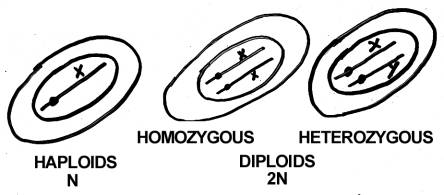
2. Multinucleates (haploid
nuclei)
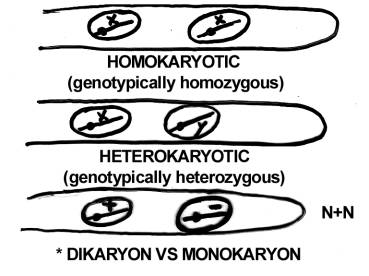
81a
(Back
to main points)
Review
- ploidy and nuclear conditions in fungi
1.
Majority of fungi are vegetatively haploid, but
some are vegetatively diploid totally or in part
2.
Majority of fungi are vegetatively multinucleate
in total or in part, but some are vegetatively
uninucleate.
3.
Multinucleate fungi with genetically identical
nuclei are homokaryons, whereas those with
genetically different nuclei are heterokaryons.
4.
Multinucleate fungi with opposite mating-type
nuclei are dikaryons.
5.
Exact perpetuation of the dikaryotic condition
occurs in some higher fungi.
a.
in many euascomycotina by crozier
formation*
b.
in some heterobasidiomycotina and some
homobasidiomycotina by clamp formation**
*immediately
prior to ascus production.
**during
normal hyphal growth of dikaryons.
(Back
to main points)
|

